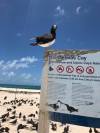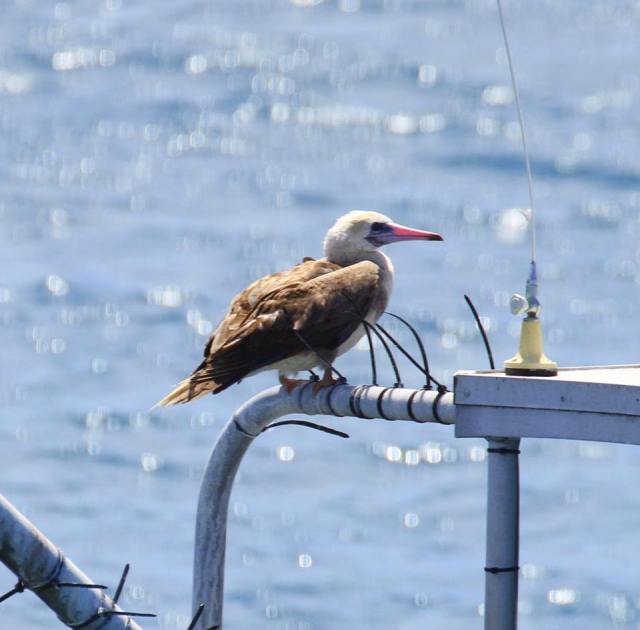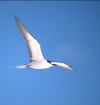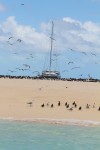This report covers the spectacular Michaelmas Cay, one of Australia’s must-visit, and most delightful birding locations. It’s usually combined with a trip to Cairns, covered in another report (see Birding Cairns and Far North Queensland). in the Cairns area of the Great Barrier Reef, this is the only destination offering birdwatchers the opportunity to experience a seabird rookery with high species diversity and large populations. Being a large cay, it is home to an enormous number of sea birds. An amazing 40,000 seabirds have been recorded at one time! It is also a major seabird nesting island in the northern Great Barrier Reef, with the main breeding species being Sooty Tern, Lesser Crested Tern, Crested Tern, Common (Brown) Noddy, and Brown Booby. Sooty Tern numbers are at their highest in winter, while Common Noddy, Crested and Lesser Crested Tern numbers peak during in Spring and Summer.
This report provides some general information about Michaelmas Cay on the Great Barrier Reef, a birding site I usually visit when conducting my bird tours to Cairns. This report provides a summary of those trips.

Located on the western edge of the Great Barrier Reef, Michaelmas Cay is around 40 km east of Cairns (have a look here: -16.606321, 145.973792). It’s around three and a half metres high and one and a half hectares in area. This makes it the largest uninhabited coral cay in the region and sustains a permanent, low grassy area the size of two football fields.
Note: There are two boats that head out to Michaelmas Cay, both leaving from Cairns Harbour. The first is the Ocean Spirit, a quicker boat that, as a result, stays at Michaelmas Cay longer. The other is the Sea Star 2, which is relatively cheap, but heads to another reef site (Hastings Reef) after leaving Michaelmas Cay. To get on board, you simply need to turn up at the ticket purchasing area and buy your ticket. I’d probably recommend booking in advance (online, for instance) just to be sure.
Landing is made onto the beach on the northern side. Here there is a fenced-off area, giving you a pretty good view of the birds of most of the island. This area of beach is the only area to which visitors are allowed, to avoid disturbing the nesting birds, and to which boats may approach. Access to the southern side, and into the vegetated area, is forbidden.

Michaelmas Cay’s vegetation consists of a low-growing mat of grasses and herbfields, interspersed with patches of bare sand. The vegetation cover varies considerably from season to season. Essentially six plant species of plants are established there. These are:
Beach Spinifex (Spinifex sericeus), an important pioneer species that colonizes sandy areas such as coastal dunes.
Goat’s Foot (Ipomoea pes-caprae), another sand stabilizer with an attractive purple flower. Goat’s Foot is a salt-tolerant plant that uses oceanic dispersal, with floating seeds that are unaffected by salt water.
Stalky Grass (Lepturus repens), again another sand binder that’s fairly common in tropical and sub-tropical coastal areas, especially coral sands. Stalky Grass is the preferred breeding platform of Common Noddy.
Bulls Head Vine (Tribulus cistoides), with yellow flowers running on the ground like a creeper.
Sea Purslane (Sesuvium portulacastrum), a salty succulent that can be eaten raw and is a good source of vitamin C.
Punarnava (Boerhavia diffusa), a creeping perennial that is taken in herbal medicine for pain relief and is used as a green vegetable in many parts of India.
There has been some concern about vegetation on the cay, with vegetative areas reduced in recent years. It was feared that this may have a negative effect on seabird nesting, with many birds nesting among vegetation.

Brown Booby. On your way out to Michaelmas Cay, you might see several birds roosting on the channel markers. They are common and breed on the island. Expect to see a hundred birds or so. They nest on the ground and can use anthropogenic marine debris (such as plastics) as a nesting material.

Red-footed Booby. Considered reasonably rare when I first visited Michaelmas Cay, you can now see as many as a dozen birds at one time. They’ll be roosting on one of the glass bottom boat what is moored next to the island when you first arrive. If you want to see them, though, it is important to be vigilant when arriving. This is because they will flush when you get to the glass bottom boat, and you are unlikely to see them again after that.

Masked Booby. I have only ever seen one at Michaelmas Cay, with a single bird roosting on the glass bottom boat, so it’s worth looking for them when you first arrive.
Great Frigatebird. They will often roost on some of the dead trees and scrubs at the northern end of the island. You might also see several birds flying high in the sky, preparing to chase and harass other seabirds as they come into the island, forcing them to regurgitate recently captured meals, swooping down to steal the meal before it hits the water.
Lesser Frigatebird. Like Great Frigatebird, there is chance of seeing a few birds roosting on logs or flying high in the sky. Note that adult Lesser Frigatebird are easier to identify than younger birds. Adult males are almost entirely black, with a red throat and white spurs emanating outward from the body onto the wing.

Common (Brown) Noddy. There are literally thousands on the cay, and it is one of the birding highlights of any trip to Michaelmas Cay. They are numerous on the cay, compared to Black Noddy, because they nest on the ground. Black Noddy, by contrast, nests in trees. There are no trees on Michaelmas Cay, hence Black Noddy is far less common. I have noticed that the number of Common Noddy tends to increase in the spring and summer. Common Noddy nests on clumps of vegetation and rarely on the ground. The preferred platform is tussocks of Stalky Grass.

Black Noddy. Among the Common Noddy, you can occasionally find Black Noddy: a darker, smaller bird with a more striking white cap. As mentioned above, they are uncommon on the island, mainly because of the lack of trees. As Black Noddy is a nester in large colonies in trees, Michaelmas Cay is not considered a a breeding site. With birdwatching diligence, however, you should find a few birds, perhaps flying around the cay.
Australian (Gull-billed) Tern. (Note: this is now Gelochelidon macrotarsa). Uncommon on Michaelmas Cay. You might see one or two birds. You will, however, see quite a few on the way out to the island nearer to Cairns, where they are common.
Gull-billed Tern. (Note: this is now Gelochelidon nilotica). It now appears there are no records of Asiatic Gull-billed Tern on Michaelmas Cay.
Lesser Crested Tern. Numbers vary. There can sometimes be several hundred birds, while other times there are only a few birds on the cay. When present, they tend to hang out in one large group, roosting on the sand. Like Common Noddy, I have found Lesser Crested Tern numbers tend to peak in spring and summer.

Crested Tern. Pretty common, with 20 or more birds present. Again, Crested Tern numbers peak in the summer.
Sooty Tern. There are thousands of Sooty Terns on Michaelmas Cay, which hosts one of the largest breeding colonies of Sooty Terns in Australia. For example, in October 2023, there were an estimated 13,000 birds present! A truly amazing sight to see! They have this wonderful way of flying in pairs, where they glide and soar in unison. Their nests are simple scrape in the sand and one egg is laid.

Bridled Tern. I tend to see them on the marker floats and flying over the water rather than roosting on the island. Indeed, generally, they have the habit of perching on flotsam and jetsam, unlike Sooty Tern. I think the most I have seen has been around 20. Bridled Tern tends to be smaller in size than Sooty Tern and the colour of the upper surface, especially the back, is a greyish brown. The adult Bridled Tern also has a pale nape and extensive white edges on the outer tail feathers. I also think their flight pattern is more graceful and erratic, and they seem to have a lighter and more delicate build.

Black-naped Tern. Personally, I think they are probably the world’s most attractive terms! Just so delicate and sweet. When you see them, you know you are having a wonderful days birding in the waters of the tropics! I see them on most trips to Michaelmas Cay, with the highest amount being a dozen or so! Like Bridled Tern, you most often see them flying over the water and around the Cay. Like Red-footed Booby, they sometimes perch on the glass bottom boat and pontoons, so look out for them when you first arrive. If they are roosting, they’ll be on the beach near the water’s edge.

Little Tern. I usually see a bird or two hawking for fish near the Cay, although they will occasionally roost immediately next to the water’s edge.

Common Tern. Like Little Tern, I have occasionally seen the odd bird or two roosting next to the water’s edge to the north of the fenced off area. In Australia, we have renamed the Common Tern the ‘Uncommon Tern’.
Roseate Tern. One the special birds of Michaelmas Cay, there are usually one or two birds present. To see them, you generally have to go to the back of the Michaelmas Cay. To get to the back of the cay, you will need to go by boat. The boat cruise companies will sometimes take you there, but it is highly dependent on the tide (which needs to be high) – but it is always worth asking! If you can’t get to the back of the island, keep an eye open for birds flying around those areas and at sea.

Caspian Tern. Usually, several birds are present on the cay.
Silver Gull. Perhaps surprisingly, not that numerous, although they do tend to be a coastal bird of the mainland. You can usually see half a dozen or so. Silver Gull are known for predating the eggs and young chicks of the other seabird species. Keeping their numbers down, and any disturbance of Michaelmas Cay, which favours Silver Gull, is important – a major reason for the controls for vessels and visitor restrictions.

Ruddy Turnstone. Sometimes as many as a dozen birds roam the cay. Highly migratory, but birds are usually present all year round. They are known to prey on the eggs of other bird species, which may explain their presence, but I have not seen this. Most likely, they are just roaming the island for invertebrates.

Other less commonly recorded birds include: Pacific Golden Plover, Whimbrel, Far Eastern Curlew, Bar-tailed Godwit, Grey-tailed Tattler, Great Knot, Red-necked Stint, Sanderling, Wedge-tailed Shearwater (usually seen on the way to Michaelmas Cay, sometimes just offshore from Cairns), Pacific Reef Heron (aka Eastern Reef Egret), Torresian Imperial-Pigeon, Osprey, Brahminy Kite, and White-bellied Sea-Eagle.
Some of the more unusual birds recorded on Michaelmas Cay include Helmeted Friarbird, Brown Honeyeater, Sahul (Olive-backed) Sunbird, Australasian Figbird, Black Butcherbird, Spangled Drongo, Metallic Starling, and Eastern Whipbird. Seeing Eastern Whipbird out there is really something! My guess it that it’s probably and error.

Finally, don’t forget that Michaelmas Cay is surrounded by some magnificent coral reefs! So I recommended that even very keen birdwatchers also devote some time to snorkelling! The Great Barrier Reef has an amazing 1,500 species of fish. But that is another story!

